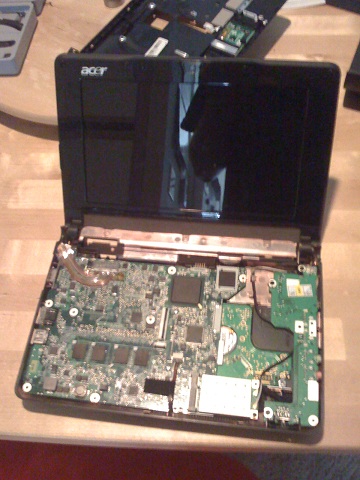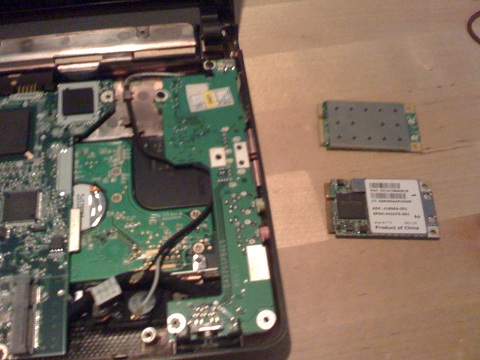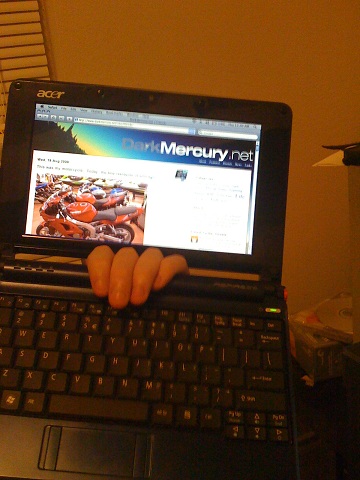





Saturday, August 29, 2009
Aspire to Greatness
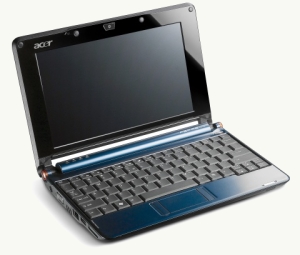 Ultraportable laptops, or netbooks, are the fastest growing segment of the PC market right now. My first encounter with one was through Krhainos and his Acer Aspire One. I didn’t understand the point of it at the time. It was slow, the screen size was tiny, the keyboard was hard to use. It wasn’t until a few months later that I started to realize just how useful one could be. I travel a lot for work, staying in a hotel overnight 2 days a week. I tried to take my macbook pro around with me, but it was heavy and I even made a small dent in the side by forgetting it was there and pushing my seat back into the case. So I tried to get by with my iPhone. It’s nice to be able to use the internet at any time without having to carry my laptop around, but the experience isn’t quite the same. You have to keep zooming in and out, there’s no java support, and the screen is just too small to use for more than a few minutes. So one night a hotel, I started to think about my old Dell L400, and how it could be neat to have one again. It was a small, thin laptop, especially for those days. It had external drives, but that was ok because I wouldn’t need them on the road. By today’s standards it’s pretty slow, but again I thought I could get by because I was only using it for internet browsing. I searched but couldn’t find much right away. The one I did find referred to it as a netbook. I thought back to Jo’s Aspire One and realized that I could get a new netbook for about the same cost, with the same features and probably not quite as slow. Being a little impatient, by the end of the day I had talked a craigslist seller down to $240 for his week-old Aspire One (retail $379), and the experiment began.
Ultraportable laptops, or netbooks, are the fastest growing segment of the PC market right now. My first encounter with one was through Krhainos and his Acer Aspire One. I didn’t understand the point of it at the time. It was slow, the screen size was tiny, the keyboard was hard to use. It wasn’t until a few months later that I started to realize just how useful one could be. I travel a lot for work, staying in a hotel overnight 2 days a week. I tried to take my macbook pro around with me, but it was heavy and I even made a small dent in the side by forgetting it was there and pushing my seat back into the case. So I tried to get by with my iPhone. It’s nice to be able to use the internet at any time without having to carry my laptop around, but the experience isn’t quite the same. You have to keep zooming in and out, there’s no java support, and the screen is just too small to use for more than a few minutes. So one night a hotel, I started to think about my old Dell L400, and how it could be neat to have one again. It was a small, thin laptop, especially for those days. It had external drives, but that was ok because I wouldn’t need them on the road. By today’s standards it’s pretty slow, but again I thought I could get by because I was only using it for internet browsing. I searched but couldn’t find much right away. The one I did find referred to it as a netbook. I thought back to Jo’s Aspire One and realized that I could get a new netbook for about the same cost, with the same features and probably not quite as slow. Being a little impatient, by the end of the day I had talked a craigslist seller down to $240 for his week-old Aspire One (retail $379), and the experiment began.
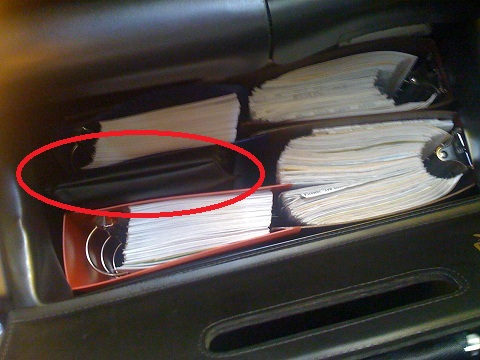 I like my 15” Macbook pro for its dedicated video card. It’s great to go to LAN parties in Ohio and not have to take much more than it and a mouse. It’s getting a little old, but still handles most things pretty well. The new Acer is great too in that it’s super light, more durable, and cheeeaaap while still giving me good enough performance to run the latest operating systems and browsers. It’s great to be able to use a real web browser, AIM, iTunes, etc again at the same time. If you want to know how wide the screen is, the white part of my website just fills up the screen (1024x600). My biggest realization was that while I enjoyed having both performance and ultra-portability, I didn’t need both at the same time. The Acer is as small as my flight manuals and fits nicely into my kitbag at work. Once I have the software set up just the way I like, I plan to leave it there at work for good. I don’t need an ultra portable laptop at home, and I wouldn’t have to drag it through security each time I went to work.
I like my 15” Macbook pro for its dedicated video card. It’s great to go to LAN parties in Ohio and not have to take much more than it and a mouse. It’s getting a little old, but still handles most things pretty well. The new Acer is great too in that it’s super light, more durable, and cheeeaaap while still giving me good enough performance to run the latest operating systems and browsers. It’s great to be able to use a real web browser, AIM, iTunes, etc again at the same time. If you want to know how wide the screen is, the white part of my website just fills up the screen (1024x600). My biggest realization was that while I enjoyed having both performance and ultra-portability, I didn’t need both at the same time. The Acer is as small as my flight manuals and fits nicely into my kitbag at work. Once I have the software set up just the way I like, I plan to leave it there at work for good. I don’t need an ultra portable laptop at home, and I wouldn’t have to drag it through security each time I went to work.
The small size does have some limitations. The keyboard is 91% full size, so it’s a little smaller and takes a little bit of use to get up to speed with. Once I stopped trying to rest my palms on the base of the laptop I got a lot faster! I do like that Acer didn’t make any strange alterations in key placement like the Dells. I like the page up and page down buttons near the arrow keys, since the screen size is smaller both the arrows and page up/down get used a lot. The touchpad also takes some getting used to, since the buttons are on the left and right sides. It’s often hard to press the buttons. They are in a little groove and it’s hard to tell by touch what is the groove, what is a button, and what is the touchpad. It results in the mouse cursor getting pissed off and flying rapidly all over the screen. I am a big keyboard command person anyways and try to use a mouse as little as possible. Try to stick to tapping the mousepad for a click.
My Aspire One is the 160Gb Hard drive version, which means Windows XP was the default OS instead of Linpus Linux. I like XP, it’s compatible with pretty much everything these days, but Linux has its uses too. Like when a hotel wants you to pay for your internet and you don’t want to… So I was interested in installing a linux build on it. Jo had the idea of installing Moblin, short for mobile-linux. It’s a linux build designed for netbooks. It had some really great ideas such as a toolbar that hides to save screen space. When you’re only dealing with 1024x600 pixels, things like the start menu just waste your precious screen space. You want to give the web browser or whatever program as much room as you can. It was also able to boot in about 5 seconds. That is pretty impressive I suppose. However, the entire setup was just far too limiting. The OS is basically crippled, lacking almost every feature you take for granted in an OS, like samba networking and the ability to change the desktop wallpaper. Installing everything you actually needed took a lot of time and increased that precious boot time up to all the other operating systems. The chrome web browser it came with could be maximized, but a third party install of firefox couldn’t. You were left with wasted screen space, the very thing moblin was designed to prevent. The multiple desktop feature was impossible to use without a mouse, and more hassle than it was worth. Little things in Moblin also make it aggravating to use. After typing in a URL to the browser, it wouldn’t change focus to the actual web page. You’d try to page up/down and the cursor would be in the URL field still. You had to then take the mouse, and click on the page just to move it around. Ugh. So I ended up giving up on Moblin. I understand it’s a beta, but it’s not ready to be used as a full time OS and so I won’t.
I do love OS X, and so with some prompting by BobOmega, I started to look into turning it into a hackintosh by installing OS X. As I read about it, it got good reviews except for one part. The Atheros wifi card in the laptop wouldn’t work because apple doesn’t use their cards and there were no drivers for them. What good is a netbook without wireless internet? However, the Aspire One uses a standard mini PCI-E wifi card, so it was just a matter of buying a compatible card (Dell/Broadcom 1490) off ebay for about $15 and opening it up to replace the card. It arrived during Quakecon, but after a few days I finally sat down and spent about 2 hours performing the surgery. I had read a lot about what to do, and some horror stories, but all went surprisingly well. Removing the keyboard was the hardest part, taking about an hour itself. I popped off the F8 key while trying to release the little tab underneath it, but fortunately it snapped back on easily when the keyboard is removed. Afterwards, it was just a simple matter of unplugging the old card and plugging the new one in. I attached the wires for the antenna and closed it back up. It detected the new card right away and I was online instantly. My “macbook mini” is complete!
OS X has become my main OS now. It gives me all the networking features of linux while being a good-looking and powerful OS. With the Spaces multi-desktop program, I can have a full screen web brower up, and press Opt + left/right to get to other virtual desktops with my AIM, iTunes, whatever, using just the keyboard. It’s easy, pretty, powerful, and user friendly. Everything a real OS should be. I see now why netbooks are becoming so popular.

